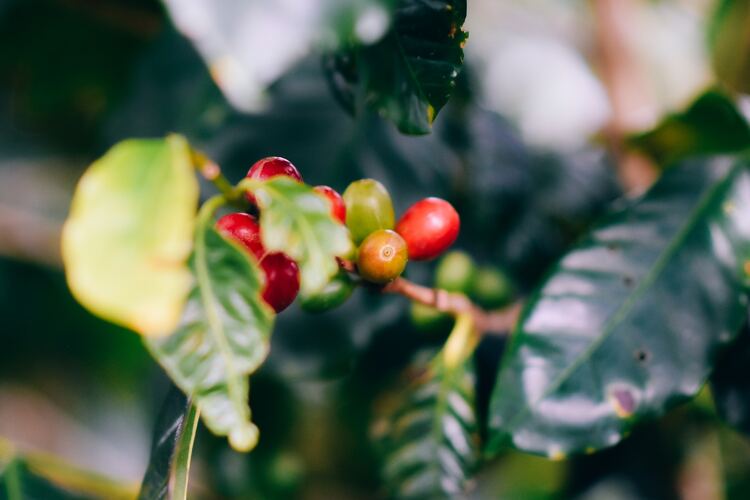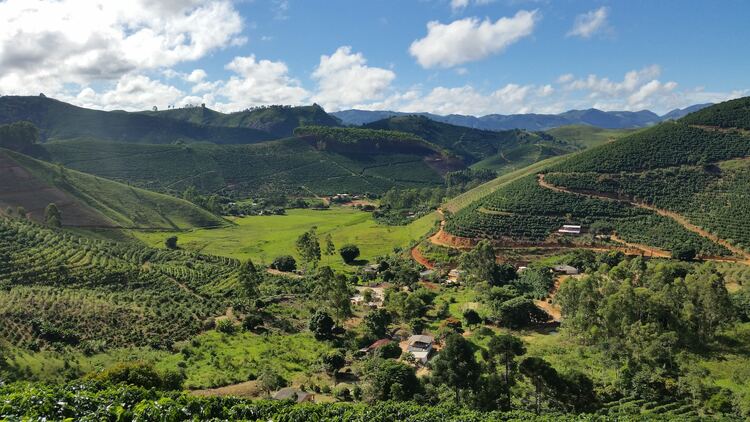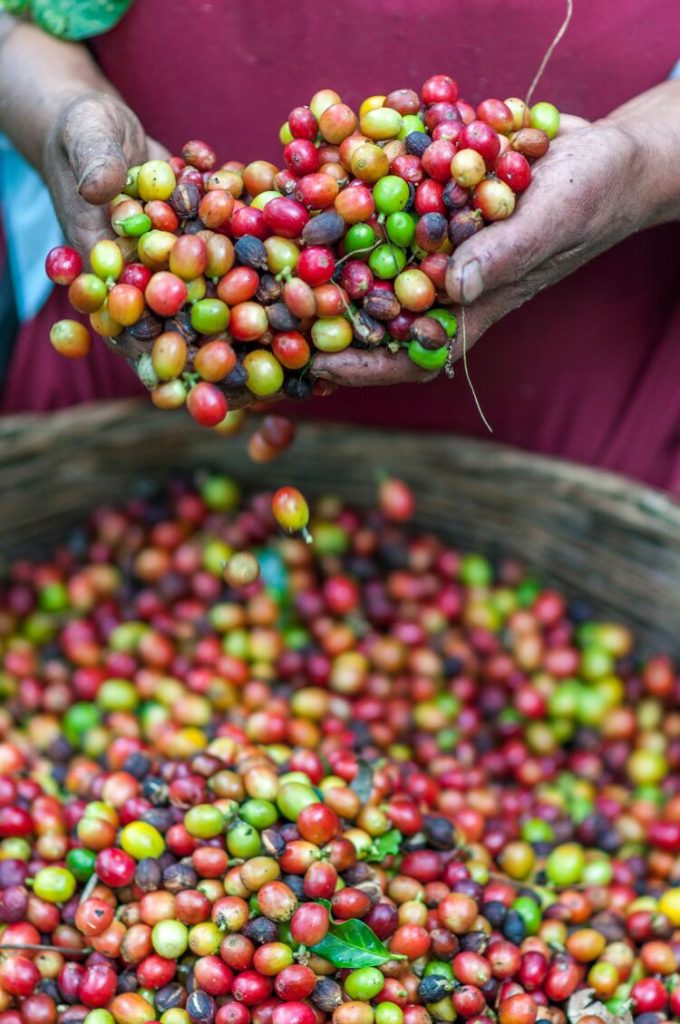In this article, I will guide you through some of the most renowned coffee growing regions, highlighting their distinct characteristics. Moreover, I am providing high-level information on the coffee growing countries within each region.
Oh, this is going to be a lot of fun! You’ll learn about the coffee-producing hotspots and gain a deeper appreciation for the complexities and subtleties of your favorite brews. Let’s dive in!
Please note: This article contains affiliate links, meaning I may earn a commission if you make a purchase by clicking a link. Of course, this comes at no extra cost to you and helps me keep offering readers solid information.

Coffee Bean Types
When you’re exploring the world of coffee, you’ll primarily come across two types of coffee beans: Arabica and Robusta. These two bean varieties comprise most of the coffee grown and consumed globally.
Arabica coffee beans, which account for about 60-70% of the world’s coffee production, are known for their smooth, delicate flavors and lower acidity. They are often considered the higher quality beans and are grown at higher altitudes, usually between 2,000 and 6,000 feet above sea level. This allows for slower growth, which leads to more complex flavors and aromas in your cup. The most famous Arabica-producing regions include Colombia, Ethiopia, and Brazil.
On the other hand, you have the Robusta coffee beans. These beans are typically more robust and bitter in flavor, with a higher caffeine content. They make up around 30-40% of the global coffee production, grown primarily in Africa and Southeast Asia. Robusta beans are more disease-resistant and can thrive at lower altitudes than Arabica, making them less expensive to cultivate.
Here are some key differences between Arabica and Robusta:
| Characteristic | Arabica | Robusta |
| Flavor | Smooth, delicate | Strong, bitter |
| Caffeine Content | Lower (1-1.5%) | Higher (2-2.7%) |
| Acidity | Lower | Higher |
| Growing Altitude | 2,000-6,000 feet | 0-2,000 feet |
| Production Share | 60-70% | 30-40% |
You might also come across blends that mix Arabica and Robusta beans to balance flavors, acidity, and strength. Learn more about coffee beans by looking at our coffee varieties article.

Major Coffee Growing Regions
It is time to look at the most popular coffee growing regions. Take notes since you may visit one or more of these areas to tour coffee estates and taste (sound good to me).
South America
South America is a prominent coffee growing region, mainly due to its vast area along the Bean Belt. This region is known for producing some of the world’s finest coffee varieties. In particular, Brazil and Colombia are the largest coffee producers in this area.
You’ll find that South American coffees have a wide range of flavor profiles, from fruity and bright to rich and chocolatey. Some common characteristics include a medium acidity and a well-rounded body.
Below is a list summarizing the stand-out features of the coffee growing countries in the region.
- Brazil, South America’s largest country, is the world’s largest coffee producer and is known for its vast coffee plantations, producing a range of Arabica varieties. Brazilian coffee is often characterized by its mild, nutty flavor and balanced acidity.
- Colombian coffee is highly regarded for its high-quality Arabica beans. The country’s diverse microclimates and mountainous terrain contribute to the unique flavor profiles of Colombian coffee, which often exhibit bright acidity, medium body, and notes of caramel and fruit.
- Peru produces a variety of specialty Arabica coffees. The coffee is grown at high altitudes in the Andes Mountains, resulting in nuanced flavor profiles. Peruvian coffees often showcase bright acidity, floral and fruity notes, and a smooth, clean finish.
- Ecuadorian coffee is grown in the diverse microclimates of the Andean highlands. The coffee boasts a distinctive flavor profile characterized by floral aromas, fruity notes, and a delicate acidity. Ecuadorian coffee is often sought after for its uniqueness and specialty-grade beans.
- Bolivian coffee is grown in the high-altitude regions of the Andes, resulting in coffee beans with exceptional cup quality. The beans typically exhibit a balanced acidity, medium body, and flavors that range from fruity and floral to chocolatey and nutty.
- Venezuelan coffee is renowned for its rich and full-bodied flavor profiles. Notes of chocolate, nuts, and spices often characterize the coffee. Despite challenges in recent years, Venezuelan coffee holds a distinct place in the specialty coffee world.
- Paraguay’s coffee industry is relatively small compared to other South American countries. However, the country produces specialty-grade Arabica coffees with unique flavor characteristics. Paraguayan coffee often exhibits a smooth body, subtle acidity, and notes of caramel, nuts, and tropical fruits.

Mexico and Central America
The portion of Mexico south of the Tropic of Cancer and Central America sits within the Bean Belt, close to the equator. This region boasts exceptional coffee-growing conditions because of its climate, volcanic soil, and high altitudes.
Central American coffees are known for their balanced, bright acidity, fruity, and nutty undertones. Some of the top coffee-producing countries in this region include Guatemala, Costa Rica, and El Salvador.
Below is a list summarizing the stand-out features of the coffee growing countries in the region.
- Mexico is a significant player in the world of coffee, renowned for its rich coffee-growing heritage. The country’s diverse regions, ranging from Chiapas to Veracruz, offer ideal conditions for coffee cultivation. Mexican coffee is primarily Arabica, known for its smooth and well-balanced flavor profiles. Mexican coffees often exhibit medium body, moderate acidity, and flavors that range from nutty and chocolatey to fruity and floral notes.
- Costa Rican coffee is known for its exceptional quality and consistency. The country’s fertile volcanic soil and high-altitude regions contribute to the coffee’s distinct flavor profiles. Costa Rican coffees often exhibit bright acidity, medium body, and flavors ranging from citrus and floral to chocolate and honey.
- Guatemalan coffee is celebrated for its complexity and diversity. The country’s microclimates, volcanic soil, and altitude variations create various flavors. Guatemalan coffees often display a full body, vibrant acidity, and tasting notes that include chocolate, caramel, fruit, and floral nuances.
- Honduran coffee has gained recognition for its consistent quality and affordability. The coffee is grown in diverse regions with varying microclimates, resulting in a range of flavor profiles. Honduran coffees typically offer a balanced acidity, medium body, and flavors that can include chocolate, citrus, and nutty undertones.
- El Salvador produces notable Arabica coffees with distinctive flavor characteristics. The country’s volcanic soil, altitude, and ideal coffee-growing conditions contribute to the coffee’s complexity. Salvadoran coffees often have a medium body, bright acidity, and flavors encompassing fruity, floral, and caramel notes.
- Nicaraguan coffee is gaining recognition for its high-quality beans and unusual flavor profiles. The country’s diverse microclimates, including mountainous regions and volcanic soil, contribute to the coffee’s exceptional characteristics. Nicaraguan coffees typically exhibit a medium body, balanced acidity, and flavors that range from fruity and nutty to cocoa and spice.
- Panamanian coffee, particularly the renowned Geisha variety, is highly sought after by coffee enthusiasts worldwide. Grown in limited quantities, Panamanian Geisha coffee showcases exceptional complexity, vibrant acidity, and an array of nuanced flavors, including floral, tropical fruit, tea-like, and jasmine undertones.
- Belizean coffee is produced in small quantities but is recognized for its unique character. Grown in the shade of diverse tree species in the lush rainforests, Belizean coffees develop distinct flavors. They often exhibit medium acidity, a balanced body, and notes that range from chocolate and caramel to fruity and nutty undertones.

Caribbean
The Caribbean, although not as widely recognized as other coffee-producing regions, holds its unique charm in the world of coffee. The region’s volcanic soil, tropical climate, and rich cultural heritage contribute to producing exceptional coffees.
Several Caribbean countries have made their mark in the industry, showcasing their distinct flavor profiles and cultivating a loyal following among coffee enthusiasts.
Jamaica stands out as one of the most renowned coffee producers in the entire world. The country is famous for its Blue Mountain coffee, one of the world’s most prized and exclusive coffees. Grown in the mist-shrouded peaks of the Blue Mountains, this Arabica coffee boasts a smooth, mild flavor with bright acidity, gentle sweetness, and hints of floral and fruity notes.
Another notable coffee-producing country in the Caribbean is the Dominican Republic. The country’s coffee plantations thrive in the fertile soil of its mountainous regions. Dominican coffee is predominantly Arabica and offers a diverse range of flavor profiles. Depending on the microclimate and growing conditions, Dominican coffees can display chocolate, caramel, tropical fruits, and spices notes.
Puerto Rican coffee holds a special place in the hearts of coffee connoisseurs. Grown in the lush mountains of the island, Puerto Rican coffee showcases distinct characteristics that set it apart. Puerto Rican coffee is primarily Arabica and offers a balanced cup with medium body, bright acidity, and flavors that range from nutty and caramel to fruity and chocolate undertones.

Africa
Africa is the birthplace of coffee. With its rich history, this region covers a vast area within the Tropic of Cancer and the Tropic of Capricorn. The African continent yields unique and alluring coffee flavors due to its diverse climates and growing conditions.
Notable African coffee-producing countries include Ethiopia, renowned for its fruity and floral coffees, and Kenya, which offers bright and acidic varieties.
Below is a list summarizing the stand-out features of the coffee growing countries in the region.
- Ethiopia is the birthplace of coffee, and its coffee culture is deeply rooted in the country’s history. Ethiopian coffees are known for their wide range of flavor profiles, including fruity, floral, and wine-like characteristics. The traditional processing method called “natural” or “dry” processing, where the coffee cherries are dried with the fruit still intact, contributes to Ethiopian coffees’ unique and distinct flavor notes.
- Kenyan coffees are highly regarded for their vibrant acidity, complexity, and intense flavors. Combining high altitudes, rich volcanic soil, and meticulous processing methods results in exceptional coffee profiles. Kenyan coffees often exhibit bright citrus acidity, berry-like flavors, and floral aromas, making them prized by specialty coffee enthusiasts.
- Tanzanian coffee production includes both Arabica and Robusta varieties. Arabica coffee from Tanzania is known for its bright acidity, medium body, and flavors ranging from fruity and floral to chocolatey and wine-like. Additionally, Tanzanian Peaberry coffee, a unique mutation where a single coffee bean develops in the cherry instead of the usual two, is highly sought after for its concentrated flavor and smoothness.
- Rwandan coffee has gained recognition for its exceptional cup quality and inspiring story of resilience and growth. The country’s coffee industry has made significant strides in producing specialty-grade coffees with distinctive flavors in recent years. Rwandan coffees often showcase bright acidity, floral notes, and balanced sweetness, offering a delightful combination of complexity and elegance.

Asia
Asian coffee-growing regions lie mainly around the equator, within the Bean Belt. The largest coffee-producing countries in Asia include Indonesia, Vietnam, and India.
Compared to other regions, Asian coffees exhibit bold, earthy, and robust flavors. They often have a low acidity and a full body, making them great for espresso blends.
Below is a list summarizing the stand out features of the coffee growing countries in the region.
- Indonesian coffees, such as those from Sumatra and Java, are renowned for their unique earthy and spicy flavor profiles. They often possess a full body, low acidity, hints of herbs, dark chocolate, and tobacco. The country’s traditional processing method called “wet-hulling” or “Giling Basah” contributes to the distinct characteristics of Indonesian coffees.
- Vietnam is one of the largest producers of Robusta coffee in the world. Vietnamese Robusta beans are known for their bold, full-bodied flavor and higher caffeine content. The country’s coffee industry has developed its own style of brewing, particularly with the popular “Ca Phe Sua Da” (Vietnamese iced coffee) that combines strong Robusta coffee with sweetened condensed milk.
- Indian coffee production primarily includes Arabica and Robusta varieties. Indian Arabica coffees, such as those from the region of Coorg, are known for their mild acidity, medium body, and flavors that range from nutty and chocolatey to fruity and floral. Indian Robusta coffees, particularly those from the state of Karnataka, exhibit bold flavors and are often used in espresso blends.
- Thai coffee has gained recognition for its specialty-grade Arabica beans. Coffee cultivation in the northern regions of Thailand, such as Chiang Mai and Chiang Rai, has flourished. Thai Arabica coffees often showcase medium acidity, a well-balanced profile, and flavors that can include floral, fruity, and chocolatey notes.
- Philippine coffee has a rich history and is known for its Barako variety, which is predominantly Robusta. Barako coffee is cherished for its strong and bold flavor with hints of dark chocolate and spice. The country’s specialty coffee scene is also growing, with Arabica varieties from regions like Benguet and Sagada gaining recognition for their unique profiles.
- Chinese coffee production has been increasing in recent years, particularly in Yunnan province. Yunnan coffee is primarily Arabica and offers a diverse range of flavor profiles influenced by the region’s altitude and climate. Chinese Arabica coffees can showcase bright acidity, floral and fruity notes, and a delicate sweetness.

Middle East
The Middle East, though a smaller player in the coffee-growing world, is steeped in coffee history and culture. Located mainly within the Tropic of Cancer, countries like Yemen produce distinctive Arabica beans known for their complex and spicy flavors.
Hawaii
Hawaii, a part of the United States, is uniquely positioned as a coffee-growing region. The island produces the celebrated Kona coffee thanks to its volcanic soil and tropical climate. This coffee is characterized by its medium body, bright acidity, and smooth and sweet flavor profile.
Coffee Growing Regions: Recommendations
If you are interested in buying beans from the coffee growing regions highlighted in this article, here are some recommendations:
Peet’s Coffee, Medium Roast Ground Coffee

Amazon Fresh Colombia Whole Bean Coffee

Allegro Coffee, Organic Mexico Light Roast Ground Coffee

Copper Moon Guatemalan Antigua Blend

Plantation Blue 100% Blue Mountain Coffee from Jamaica

Kenya AA Coffee, 100% Pure, Whole Bean, Fresh Roasted

Java Planet Organic, Sumatra Single Origin Dark Roast

Frequently Asked Questions
What factors influence the quality of coffee in different growing regions?
Various factors influence the quality of coffee, including soil composition, altitude, climate, and local farming practices. Each factor can significantly impact a coffee plant’s growth and flavor profile.
How do altitude and climate affect coffee growth?
Higher altitudes typically produce better coffee because the slower growth allows coffee beans more time to develop complex flavors. The climate also plays a significant role, as coffee plants need a specific balance of rainfall, sunshine, and temperature to thrive. Generally, coffee grows best in tropical regions with mild temperatures and distinct wet and dry seasons.
What are the flavor profiles of coffee from various regions?
Different coffee growing regions have unique flavor profiles. For example:
- African coffees are known for their fruity and floral notes, often accompanied by bright acidity.
- Central and South American coffees showcase bright, clean flavors with chocolate, nuts, and citrus hints.
- Indonesian coffees present earthy, spicy, and herbal flavors with full-bodied textures and lower acidity.
Keep in mind that these are generalizations, and there will be some variation depending on the specific coffee and processing methods used.
Which countries are the top coffee producers?
The top coffee-producing countries are Brazil, Vietnam, Colombia, Indonesia, and Ethiopia. These countries grow the majority of the world’s coffee, although many other nations also produce significant quantities.

By exploring these major coffee-growing regions, you can experience a wide range of flavors and aromas, giving you a better understanding of the diverse world of coffee. So go ahead and dive into these regions and discover your favorite!
Tell me, what are your favorite coffee growing regions? Do you like coffee from a specific country?